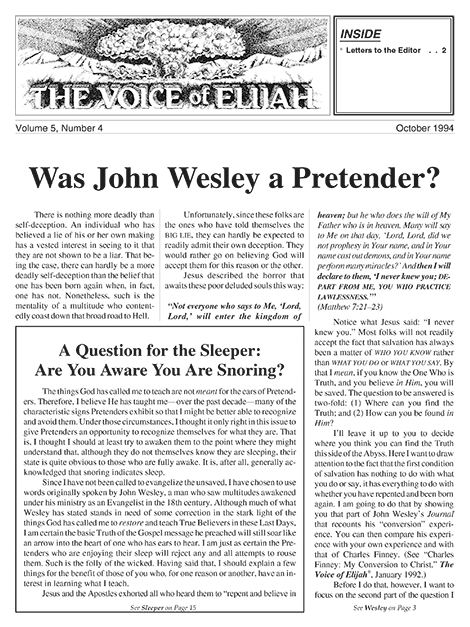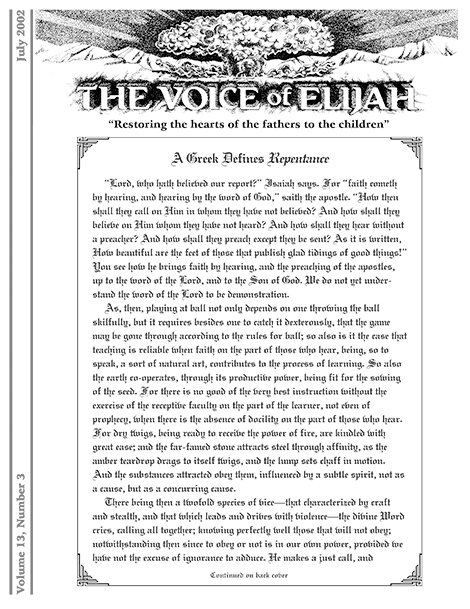It Is Impossible to Renew Them Again to Repentance
This article looks into the denotative and connotative meanings of the Hebrew and Greek words that are translated “repent” in the Scriptures. It also explains the importance of making a distinction between true repentance and false repentance.
The Forecast
The purpose of this column is to explain various weather-related parabolic images that relate to the Last Days and the Second Coming of Jesus Christ. This edition looks at current events in terms of the parabolic image of the “winds” that Jesus mentions in the Parable of the Wise Man Who “built” His “house” upon the “Rock.”
Questions & Answers
The preponderance of this set of “Questions & Answers” is given over to a discussion of passages that relate to the need for True Believers to “count the cost” of “building The House” of God. That response includes an examination of salt as a parabolic image. The final question asks whether Satan can read our thoughts.
Excerpt From Newsletter
The Truth is, “the Gospel” was the message that John the Baptist, Jesus, and the twelve disciples delivered to “the people.” But Matthew and Luke make a fairly clear distinction between “the Gospel” which Jesus “proclaimed,” or “preached,” to everyone and the rest of The Teaching which He “taught” only to the Jews. In two of the instances where Matthew mentions both activities, he says Jesus was “proclaiming” (“preaching”) the Gospel openly to everyone and “teaching” only in the synagogues:
And {Jesus} was going about in all Galilee, teaching in their synagogues, and proclaiming the gospel of the kingdom, and healing every kind of disease and every kind of sickness among the people.
(Matthew 4:23)
And Jesus was going about all the cities and the villages, teaching in their synagogues, and proclaiming the gospel of the kingdom, and healing every kind of disease and every kind of sickness.
(Matthew 9:35)
It is important to make a clear distinction between the Gospel and The Teaching for a variety of reasons, not the least of which is the separation one needs to keep between the office of the Evangelist, who is charged with “preaching” the Gospel to those outside the Church, and that of the Teacher, who “teaches” The Teaching to those inside. (See “What’s Left of the Right That Stayed Down When He Went Up?” The Voice of Elijah® Update, September 1995.) But perhaps the most important reason for not confusing the two has to do with understanding the meaning and significance of some of the parabolic pantomimes that Jesus conducted. As John records what Jesus slyly said to the high priest, He “spoke” (the Gospel) openly anywhere and everywhere to the crowds (“the world”) that followed Him, but He “taught” (The Teaching) only in the synagogues and the Temple (to the Jews):
The high priest therefore questioned Jesus about His disciples, and about His teaching. Jesus answered him, “I have spoken openly to the world; I always taught in synagogues, and in the temple, where all the Jews come together; and I spoke nothing in secret.”
(John 18:19–20)
In that exchange, Jesus is using a fine distinction between “speaking” and “teaching” to mock the ignorance of the high priest in regard to things explained in the Gospel and The Teaching.
“It Is Impossible to Renew Them Again to Repentance,” The Voice of Elijah®, July 2002, p. 2
Newsletter Details
| Contribution of | $6.00 |
|---|---|
| Pages | 20 |
| Author | Larry Dee Harper |
| Language | English |
Related Information

Was John Wesley a Pretender?
This article examines the life and work of John Wesley in an attempt to determine whether or not his conversion was genuine. It includes an excerpt taken from Wesley’s Journal in which he recounts the events leading up to his conversion experience. The provocative conclusion is, he may or may not have been a Pretender, but his Journal is certainly interesting reading.

The Old Testament Gospel of Jesus Christ
This 60-page booklet exposes several popular beliefs as nothing more than Satan’s lies. It then goes on to explain the content of the Old Testament Gospel message of salvation that one must believe to be born again.

The Way, The Truth, The Life
This seminar examines the history of The Truth of the Word of God that the Prophets concealed in the Hebrew Scriptures, which is The Way by which The Life is attained. It explains what Jesus had in mind when He said, “I am the Way, the Truth, and the Life” (John 14:6). Subjects discussed are:
- The Way: The Mystery of Scripture
- The Truth: God’s Gift of Knowledge
- The Life: Founded on a Knowledge of the Truth
The Truth is Available
Check Out the Online Library
Browse through our library of booklets and newsletters—absolutely free!
Start Reading Now
